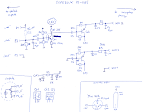 |
| From Chris’ Miscellanea |
The microphone part is glued, but after heating it gently to about ~40..50 °C with a hair-dryer or a heating gun used for heat-shrink-tubing, it can just be pulled apart by hand.
 |
| From Chris’ Miscellanea |
The proper way to adress the connection issue is to use a proper phantom-power adapter for electret microphones, luckily this taiwanese producer of cheap (and a little crappy) audio electronics also has something in store. The Superlux PS 418-S adapter!
Inside, this little marvel looks like this: Mostly through hole, one-sided PCB, waves-soldered.
 |
| From Chris’ Miscellanea |
The schematics mostly adheres to the often copied "Schoeps" design, here's my attempt at the schematics.
 |
| From Chris’ Miscellanea |
I think I got the type of Q1 wrong. It's probably wired as an emitter follower (the voltage gain of the drawn common emitter amp of 22x would be unreasonably high) with Q1 being a KSA1015 PNP Epitaxial Silicon Transistor. Q2 and Q3 are likely KTA1268
EPITAXIAL PLANAR PNP TRANSISTOR.
The PCB is small enough to fit it inside one of the earcups of the HMC660. Just cut open the direct connection that go from the 6-conductor XLR & TRS cable (braided copper, yellow, green) to the 3 wires that make their way into the gooseneck (white, black, red).
 |
| From Chris’ Miscellanea |
 |
| From Chris’ Miscellanea |
Here's the PCB inside a piece of heat-shrink tubing, but in the end, I opted to just hot-glue the bare PCB into the cup. Also some foam (from inside the PS-418's small shipping box) was added to prevent the whole thing from rattling around.
 |
| From Chris’ Miscellanea |
Here you go. 39€ + 19,90€ for a only halfway crappy headset ;-).
No comments:
Post a Comment